Taklamakan desert
Friday, November 18, 2011
- Silkroad
The last evening in Kashgar we really enjoyed again. In a Chinese restaurant we filled our stomachs with many delicious dishes.
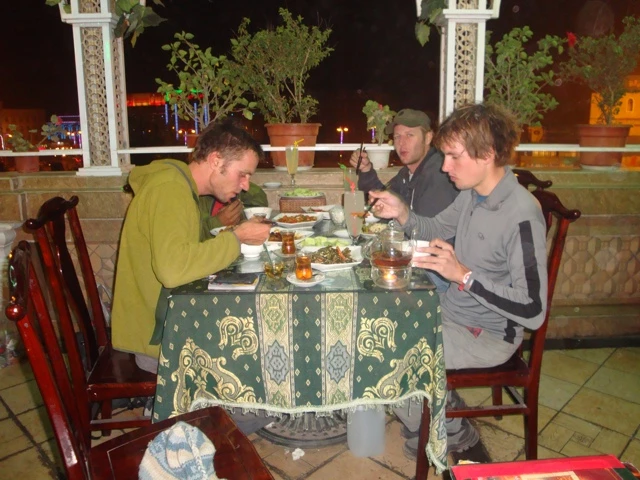
Even the next day we still felt tired from the food and did not leave until 2:00 pm. There are two main routes through the Taklamakan Desert since the dawn of the Silk Road: the Northern and Southern Silk Road.
We decided to choose the south route. Maybe we could catch a glimpse of the Himalaya Mountains and admire the K2 (8,611 meters above sea level). The first three days led the road through relatively densely populated area with a lot of farmland. In October, the cotton harvest is in full swing here. But also corn, vegetables and fruits, which are grown in huge hothouses made of clay, can be found everywhere in the markets.
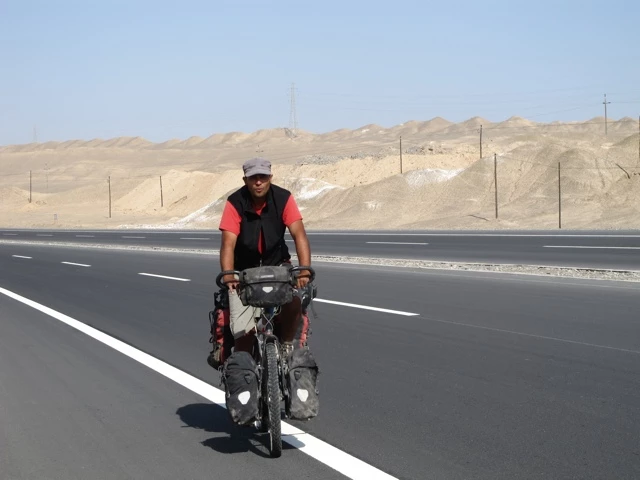

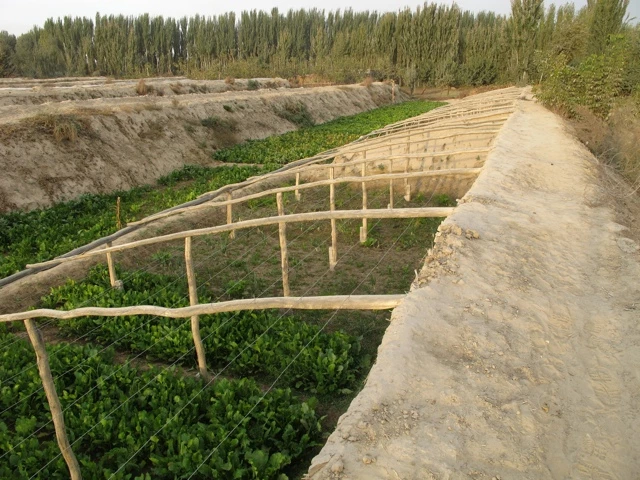

Unfortunately, the K2 did not show up. Even in China there is fog in the fall. Even the cemeteries are made of clay.

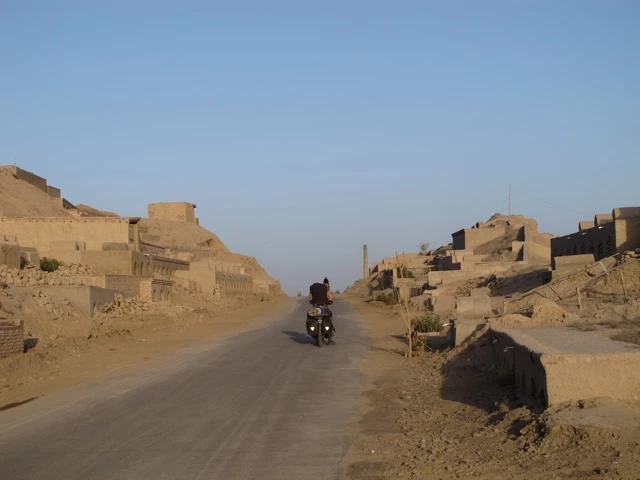
Somehow the graves are pretty handy. I do not want to be buried in it anyway. They do not look comfortable.
The street scene is usually made up of a colorful mix of electric scooters, motorcycles, huge overloading trucks, bicycles and various livestock, such as oxen or donkeys, carrying all sorts of things on their cars. Partly the dense traffic leads to quite turbulent situations. In China, it seems to be common to honk every overtaking maneuver. That you could also simply reduce the pace and is by far outdated apparently no one has come to mind. Even the police drive at full throttle through inhabited area. At first we packed all the curse words from our vocabulary. But at some point we had to confess hopelessly that all swearing is no use.


At least the roads are in top condition. As soon as we stop somewhere we are surrounded by onlookers. Tim in particular, with his dark complexion, keeps on talking. Luckily, the Uighur language is Turkish. So we can at least communicate a bit with the population. Possibilities to pitch his tent are here like sand on the sea. After three days, the villages are becoming scarcer and soon we meet the first camels.

The Taklamakan Desert is already the fourth desert on my journey. Slowly I got used to the sand. Over time, it spreads everywhere. It crunches from time to time in the clothes, in the tent, in the sleeping bag and even in the food. After only half a week we found our rhythm.
Throughout China, the watches are put on Beijing time, although there are several different time zones. Because of this, the sun does not rise until 9 o'clock in the west. We usually arrange the day as follows: Get up at 9:00, cook breakfast and play Yatzi. Jump on the bike at 12:00 o'clock and after at least one hour at the first little store drink cola and eat chocolate or nuts. At 18:00 clock is usually late after work.
Then it's time to set up a tent, cook food and play Yatzi again. In long stages, we treat ourselves in between times a noodle soup. The finished soups are packed in bags in every shop and seem to be the national dish number one. You can squeeze them at any time of day and just need to empty hot water into a bowl. Just the thing for a quick meal in between. Xinijang is a fascinating province with a wild history. Already at the people we always notice big differences. Some look like Kyrgyz, others more like Mongols and, of course, Chinese.
Xinijang, the "new frontier" of China (meaning the name translates), has been the target of rival powers for centuries due to its enormous size. The independence-minded people of this region have never been truly independent. Today, Xinijang "belongs" to China, after centuries inextricably linked with the Middle Kingdom in a push-pull relationship that China continues to pursue today.
Xinijang is like a separate country within China's borders. Here the language is not another dialect, it belongs to a completely different language family. The province is larger in area than Alaska (one-sixth of China's total area), hyper rich in Silk Road stories, populated by a colorful mix of nearly 50 ethnic minorities, geopolitically very important as it borders eight nations and sits on nearly 30% of China's oil reserves , In total, nearly 21 million people live here.
In addition to the camels, sheep, donkeys and goats, there are also other funny desert inhabitants. As soon as the asphalt warms up a bit in the morning, small lizards come to the street for sunbathing. They are extremely nimble and always hurry away when we approach.

The Manchu Army invaded the city in 1755 and ended that reign. In the 1860s and 1870s, there were several Muslim uprisings throughout western China and after Russian troops withdrew from the region in 1881 after a 10-year occupation, waves of Uighurs, Chinese Muslims (Dungans) and Kazakhs fled to Kazakhstan and Kyrgyzstan.
With the fall of the Qing dynasty in 1911 Xinijang came under the rule of several successive warlords, in which the Kuomintang (KMT, the Nationalist Party) could do little.
The only attempt to create an independent state took place in the 1940s. A Kazakh named Osman led a rebellion of the Uighurs, Kazakhs and Mongols. He subjugated the southwestern Xinijang and built in January 1945, the Republic of East Turkestan. However, the KMT convinced Muslims to give up their new republic and in return offered them genuine autonomy.
After the seizure of power by the communists in 1949, a Muslim league emerged in Xinjiang, which defied Chinese rule. Strangely enough, several of her prominent leaders died soon afterward on their way to Beijing for the crash of their plane. Organized Muslim resistance to Chinese rule collapsed, although the Kazakh Osman fought on until it was captured and executed by the Communists in 1951. All cities were provided with a Mao statue in the center. Here each represented by the great Mao, who shakes hands with the little Uighur.
For us, this symbolism is in each case quite practical for the first orientation in a new city. But it also discriminates symbolically the Uighurs. In the evening we saw many couples dancing in front of the statue in the square in Hotan. Really romantic.
Since 1945, China's main goal has been to suppress ethnic separatism while at the same time flooding the region with Han settlers. The Uighurs once accounted for 90% of the population of Xinijang, today this number has dropped below 50%. China's campaign to develop the West launched in 2000 continues. Han Chinese are encouraged by social and economic incentives to emigrate to western provinces. Beijing has channeled nearly $ 100 billion into Xinjiang's infrastructure (especially, of course, to tap into and exploit its vast oil and gas reserves).
After six days we reached Hotian. The hotel search was not easy. In some hotels they did not want to accept foreigners and mostly nobody spoke English. Fortunately, Tim and Andi had a Mandarin phrasebook with them. So we managed to find a hotel after a long search. The Uighur cuisine is quite similar to Central Asian and is also a meaty affair. Luckily, there are many fast food restaurants in Hotan. So we were able to enjoy a real pizza. My first for months! Dairy products are pretty rare here. Butter and cheese do not exist. Also Schoggi is not always easy to get. We always rave about the delicious specialties from the homeland. What would not we do for a fondue or a glass of Rivella?
The big specialty in Hotan is the Sunday market. The whole desert seems to meet here on this day. You can find everything. Through almost the whole city, the market extends. Everything is divided into different "subject areas". For example, all the clothes retailers are in one place, the toolmakers share another part with the carpenters, and those who need food find everything in huge quantities.


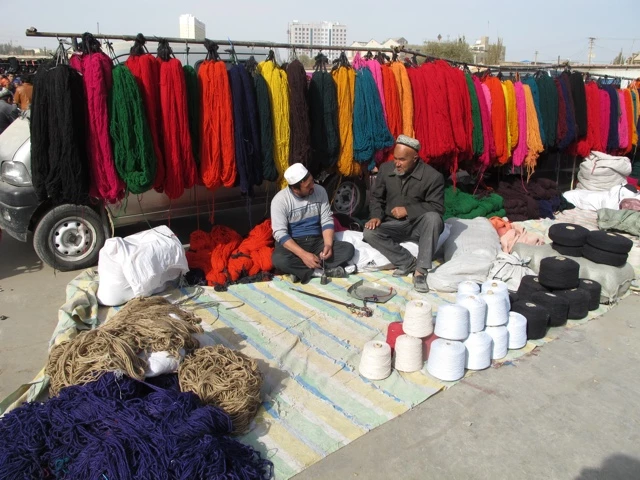
The highlight for me was the animal bazaar. Sheep, goats and goats are brought here to the slaughterhouse. Cows and camels can be bought here. A camel costs about 13,000 yuan (6 yuan = 1US $), about 2,000.- CHF. Each animal is tested for specific characteristics. The negotiations are led by men. There are usually heated discussions that we did not understand. But also cows are offered. We were by far the only tourists. The people were extremely polite to us and let us shoot pictures and things all the time. A very pleasant mood.
Fully packed and freshly fortified, it went on the next day in the vast desert. Kurd groaned rather under the weight. Fortunately, our cards are written in English and Chinese. Otherwise, it would be quite difficult to understand the road signs.
Although traffic rules are hardly considered, the Chinese seem to attach great importance to correct and as many signage as possible. For me that needed a little time to get used to in the beginning. After all, it was a miracle on the Pamir Highway when a sign appeared somewhere. On the second day, Tim and Andi celebrated their 10'000 kilometers since the beginning of their journey. Since I do not have an odometer and probably already drove so much, we celebrated in a threesome.


By the end of China it will certainly be 5,000 kilometers more!
The wind turned against us once more. Just in time against 13:00 clock such a strong headwind put in each case that we came only very slowly forward. I was exhausted from the fight in the evening.
In addition, our travel know-how card played a pretty bad strike with us: while it's practically all over China on a map, apparently some bugs crept into the production. At a scale of 1: 4'000'000 that can happen. But that had fatal consequences for us. Shortly after Mingfeng we discovered a fantastic campground between the sand dunes.


The next town would have to come the next day according to the map after 80 kilometers. The only chance to get water. When all our water supplies were used up after 90 kilometers, we started to stop all vehicles and beg for water. So after an hour we had 4 liters of water together. A car even gave us one kilogram of fresh apples. We learned that the next village is still at least 30 kilometers away. Thank you travel know how for this fatal mistake! Quite thirsty and hungry, we sneaked into our sleeping bags. When we actually arrived the next day after 60 kilometers in a village with grocery store, we were all very relieved.

I have never felt so happy in my life at the sight of filled shelves. We longed so much for civilization that we covered 110 miles the next day within 3.5 hours to Qiemo. A personal record. My Allerwertester then hurt pretty hard. Qiemo is a pretty small provincial town compared to Hotan and Kashgar. Foreign tourists do not seem to have much here. On the first day we ate so many sweets that I felt pretty bad afterwards.
The bike pants are torn slowly. Also from Andi. At the bazaar we found a seamstress mending our holes on an old sewing machine.
Here is traded mainly with jade. At the time of the Silk Road, this rock, along with silk and spices, was one of the most important commercial products. The stones are offered here in all shapes, colors and sizes.

We decided to stay a day longer in Qiemo to recover properly. The breakfast buffet in the hotel was not quite our expectations. It is delicious fresh pasta and vegetables to be served with tea, but not in the morning! So we bought yogurt, oatmeal and fruits on the market and conjured up a delicious Birchermüesli. On the way back, when I went shopping for fresh bread, I saw pig heads and feet flamed and a dog with a furred coat lying in the pan. What does not exist at the other end of the world.
Especially difficult in Chinese is to emphasize the words correctly. When Andi wanted to order salt for the eggs, the waitress returned with a pack of cigarettes. The Chinese always have a lot of fun when strange misfortunes happen to strange foreigners. For us this is usually amusing. Laughter is the only universal language worldwide that everyone understands. The Chinese already seem to laugh from birth. A happy people.
We had recovered so well that the next day we had a hard time driving at all. After 20 kilometers we set up our tents in a forest of aspen and enjoyed the view of the cotton fields.


Shortly before we bought water in a shop. The shopkeeper was so pleased with our attempt to speak Chinese that she gave us a whole box of green tea right away. Wow!
The Uighurs have long swelled grudges against the Han Chinese and led in the early 1990s several rebellions; In February 1997, tensions welled over as Muslim separatists violently revolted in the northern city of Yining.
The Chinese security forces cracked down. At least nine people died and nearly 200 were injured, which according to Chinese media reports, the protests to the hitherto most violent. Hundreds of members of the Muslim population were arrested for their involvement in the uprisings; Three were executed on the day of their trial, and the remainder were sentenced to life imprisonment. In response, separatists blew up three buses in Urumqi. Nine passengers were killed and many were wounded.
Violence erupted in Yining in April 1997 when a mob attacked prisons carrying some of the February insurgents. Again, several people were wounded or killed.
In 2001, the Chinese secret police closed several mosques of the Uyghur underground in Korla; a prominent leader and several others were brought to justice and executed.
This happened before September 11, 2001. However, Beijing exploited the events of September 11 to further pressure Uighur nationalism and sent thousands of suspected "Islamic terrorists" to prison or had them executed - with the tacit consent Washington (and looking the rest of the world). Since September 11, Beijing has continued to restrict its coverage of the Uighurs issue, no doubt because of its unrealistic hope of making Xinjiang a Xi'an-like tourist hotbed and, above all, a world leader in oil production.
The love headwind was getting heavier and cooler. Slowly, the mountains of the Arjin Shan massif became visible. A sign that we were slowly approaching the end of the desert. Just before Washixia we met LiuGuofeng.
He set out 8 months ago to explore his country by bike and now drives back to Xi'an. In Washixia he invited us for dinner in a restaurant. Even though he only spoke as much English as we did Chinese, they put a heavenly meal on the table for us.
Full eaten, we drove all together from the village and set up our camp again in a Zitterpappel forest. These trees seem to be the most dominant tree species here. Through their propagation form, which is ingenious for the desert, the root brood, they can develop even under the harshest climatic conditions.
The next day we arrived in Ruoqiang, the last city for us in the Taklamakan Desert.
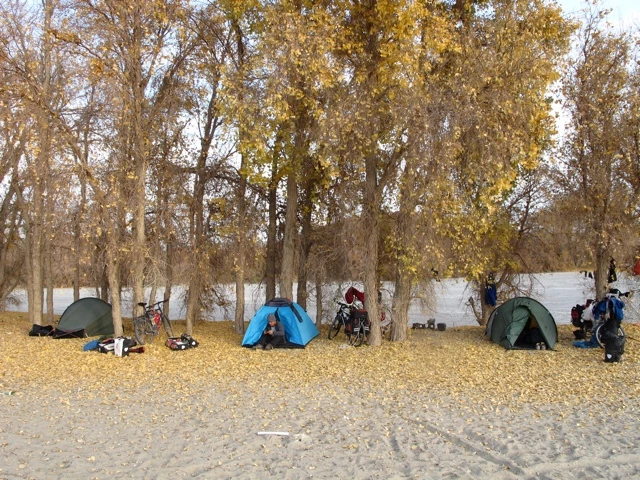
After another delicious meal and a last purchase, we said goodbye to LiuGuofeng and drove on.
The biggest spectacle in the desert is when the sun goes down. The starry sky is often gigantic to behold here. Again, our map played a trick on us: the main route actually drawn leads about 100 kilometers further east through the mountains. We invented lots of funny sayings and rhymes about the incompetent map planners at Travel Know How. Luckily, LiuGuofeng caught up with us again. We played so much Yatzi that he promptly caught us again. Well, the love of gambling! So we could use his map to transfer the correct routes and distances to our pseudo map. For two days and over 200 kilometers, there was not a single village. But from time to time smaller rest areas, beautiful campsites, dead camels and again right mountains. I almost missed them a bit.

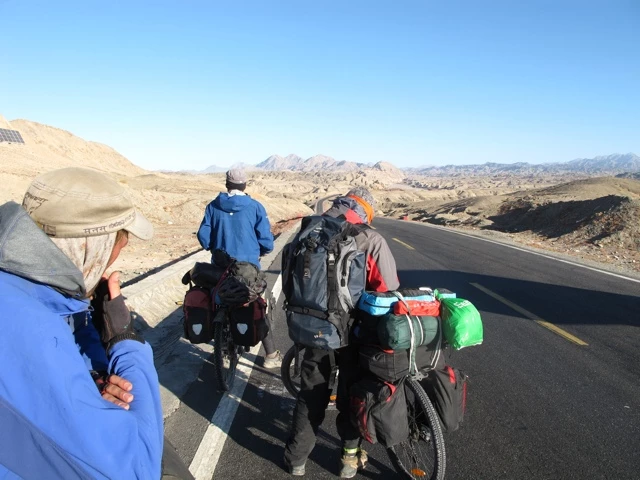


Baxikorgan is a place on the map and was our hope to finally be able to buy food again. Unfortunately, there is only a small shop selling noodle soup, car batteries and sweet drinks. After a little refreshment we drove on. The headwind was so icy and strong on that day, that we still enjoyed the time in this calm place.


On the way to the pass we lost LiuGuofeng again. He capitulated to the wind. We wanted to pitch our tents a bit lower and finally stood at 18:30 clock on the 3'855 M.ü.M. high pass.
The daily maximum temperature was 5 degrees. It was already dawn when we set up our tents completely frozen through. After a tomato soup we crawled directly into the tent. How cold it got exactly at night we do not know. We estimated about minus 15 degrees. The bottled water was completely frozen in the morning. We had no choice but to cut open the bottles to melt the ice on the stove. It took almost an hour to eat our last noodle soup.
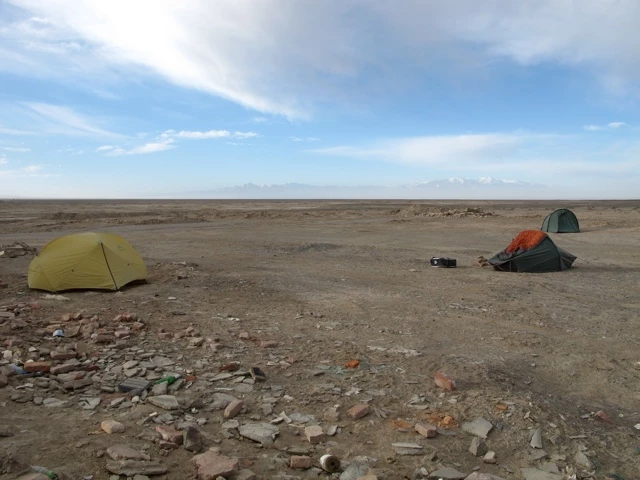

LiuGuofeng suddenly appeared again. Also pretty frozen through. Each for themselves, we fought each other again over a pass, in the first village for three days. The first shop was looted right away. It does not take much imagination to imagine how hungry we were. In the meantime, we are always counting on the individual favorite dishes from Switzerland. Butterzopf, Gipfeli, Gschwelti, Capuns or simply real Schoggi! The love Chinese do not seem to know that at all here. There are chicken legs, rice chips and many indefinable things to buy everywhere.
The people in the shop were quite happy to us strange foreigners.
When we asked for accommodation, they immediately put a room behind the store for 80 yuan! The prospect of being able to sleep warm was so tempting that we immediately accepted it. The boss of the house showed us the Dorfbeiz. What we got on the plate was by far the best food since the beginning of China for me. After a warm night we continued through the icy plateau of the Arthun Shan mountains. Huatugou is the last village with Uighur residents and definitely the end of the Taklamakan Desert. Here too crude oil is pumped out of the ground in great silence.


The oil fields extend over huge areas. Everything in Huatugou seems to belong to the oil company. Modern buildings are just in the middle of nowhere. In total there are two hotels in the village. Just right for us to use after 8 days in the saddle once again a rest day.

